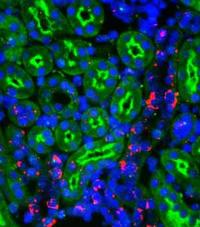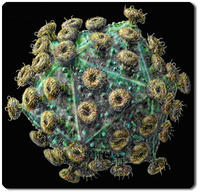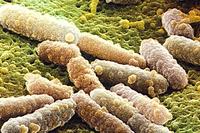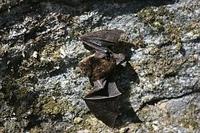-
Scientists urge more study of use of antimicrobial in food animals
The FDA the other day banned the use of some antibiotics in food animals in order to preserve the effectiveness of these antibiotics in humans; the EU is set to follow suit; scientists argue, however, that the use of antibiotics in the animal populations is unlikely to be the major source of drug resistance in humans, and question policies that restrict the use of antimicrobials in animals
-
-
Better understanding of Listeria
About 20 percent of people diagnosed with listeriosis die, compared to less than 1 percent of those inflicted by Salmonella; the harmful strains of Listeria are thus more lethal than Salmonella, but it exists in benign species and strains as well; scientists discover why some forms of Listeria are fatal and others are not
-
-
FDA bans use of some antibiotic in animals
The cephalosporin class of drugs is important in treating human diseases, such as pneumonia, skin and tissue infections, pelvic inflammatory disease, and other conditions; the FDA has just restricted the use of the cephalosporin class of antimicrobial drugs in food-producing animals in order to preserve the effectiveness of these drugs in treating humans
-
-
New Ebola vaccine protects mice
An experimental vaccine against deadly Ebola hemorrhagic fever protected more than 80 percent of mice given a lethal dose of the virus, and may protect humans as well. Unlike previous experimental vaccines, the new vaccine, which is grown in tobacco plants, is also stable enough to stockpile in case of bioterrorism.
-
-
Natural killer cells help human body fight off infections

Researchers have discovered a new type of cell which boosts the human body’s ability to fight off infections and life-threatening diseases; the researchers found a type of cell which recognizes lipid antigens, or foreign molecules, which sit on infectious bacteria which invade the body
-
-
"Left-handed iron corkscrews" a new weapon against superbugs

Scientists have taken inspiration from corkscrew structures found in nature to develop a new weapon in the fight against infections like E-coli and MRSA; researchers have created a new synthetic class of helix-shaped molecules which could be a key tool in the worldwide battle against antibiotic resistance
-
-
New compound breaks down HIV's outer envelope

One of the reasons HIV is so difficult to treat is that it continually evolves the proteins on its membrane to increase its resistance to immune systems; researchers at Texas A&M University and the Scripps Research Institute have now discovered a compound which breaks down the outer envelope of HIV
-
-
CDC concludes NBA outbreak investigation
A recently concluded investigation by the Centers for Disease Control and Prevention (CDC) reveals that norovirus was the cause of an outbreak that sidelined more than twenty-four NBA players and staff members from thirteen teams in 2010
-
-
"Vampire" bacteria may serve as living antibiotic
A vampire-like bacteria that leeches onto specific other bacteria — including certain human pathogens — has the potential to serve as a living antibiotic for a range of infectious diseases, a new study indicates
-
-
Source of St. Louis E.coli outbreak still uncertain

Public health officials in Missouri are scrambling to locate the source of an E.coli outbreak that has infected twenty-six people in one week; health authorities believe that Schnucks, a chain of salad bars, may be the culprit, but so far tests for the bacteria have all come back negative
-
-
New testing capabilities for bioterror threats
Research presented at the 13th Medical Biodefense Conference in Munich says that Abbott’s PLEX-ID system provides reliable and rapid results for key microbial biothreat agents and should be considered as a first line analytical tool for biodefense, biosecurity, and microbial forensics programs
-
-
Natural killer cells may be the best defense against anthrax
One of the things that makes inhalational anthrax so difficult for biodefense experts to deal with is the speed with which a relatively small number of inhaled anthrax spores can turn into a lethal infection; by the time an anthrax victim realizes he or she has something worse than the flu, it is often too late
-
-
New virus could be the first filovirus to cause disease in bats

A team of international researchers has discovered a new Ebola-like virus — Lloviu virus — in bats from northern Spain; filoviruses, which include well-known viruses like Ebola and Marburg, are among the deadliest pathogens in humans and non-human primates, and are generally found in East Africa and the Philippines
-
-
DHS funds Ricin detection
Positive ID announces the company’s immunodetection assay for the identification of Ricin toxin to meet DHS specifications; Ricin, a chemical warfare agent, is derived from the seeds of the castor oil plant Ricinus communis and has become a tool of terrorist groups across the world due to its easy production and high toxicity
-
-
Google Earth typhoid maps traces disease outbreaks
Recent advances in DNA sequencing have allowed scientists accurately to track the spread of some diseases by measuring mutations in the pathogen’s DNA when the DNA replicates; tracing the spread of typhoid, however, has proved challenging because these mutations are small in number and not detectable by most techniques in use
-
- All
- Regional
- Water
- Biometrics
- Borders/Immig
- Business
- Cybersecurity
- Detection
- Disasters
- Government
- Infrastructure
- International
- Public health
- Public Safety
- Communication interoperabillity
- Emergency services
- Emergency medical services
- Fire
- First response
- IEDs
- Law Enforcement
- Law Enforcement Technology
- Military technology
- Nonlethal weapons
- Nuclear weapons
- Personal protection equipment
- Police
- Notification /alert systems
- Situational awareness
- Weapons systems
- Sci-Tech
- Sector Reports
- Surveillance
- Transportation
Advertising & Marketing: advertise@newswirepubs.com
Editorial: editor@newswirepubs.com
General: info@newswirepubs.com
2010-2011 © News Wire Publications, LLC News Wire Publications, LLC
220 Old Country Road | Suite 200 | Mineola | New York | 11501
Permissions and Policies
Editorial: editor@newswirepubs.com
General: info@newswirepubs.com
2010-2011 © News Wire Publications, LLC News Wire Publications, LLC
220 Old Country Road | Suite 200 | Mineola | New York | 11501
Permissions and Policies
